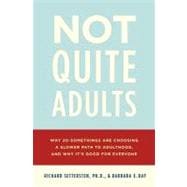
Note: Supplemental materials are not guaranteed with Rental or Used book purchases.
Purchase Benefits
What is included with this book?
RICHARD SETTERSTEN, PH.D., is Hallie Ford Endowed Chair and professor of Human Development and Family Sciences, and director of the Hallie Ford Center for Healthy Children and Families, at Oregon State University. He is also a member of the MacArthur Research Network on Transitions to Adulthood. A graduate of Northwestern University, Settersten has held fellowships at the Max Planck Institute for Human Development and Education in Berlin, the Institute for Policy Research at Northwestern, and the Spencer Foundation in Chicago. He is the author or editor of many scientific articles and several books, including On the Frontier of Adulthood. Besides MacArthur, his research has been supported by divisions of the National Institutes of Health. Visit his website at www.richardsettersten.com.
BARBARA E. RAY, as owner of Hiredpen, Inc., helps researchers and nonprofit organizations convey their work to broader audiences. She was the communications director for the MacArthur Research Network on Transitions to Adulthood, and has held positions as senior writer at the DHHS-funded Joint Center for Poverty Research, and as a managing editor at the University of Chicago Press journals division. For two years while living in the western Pacific, she was a travel writer and culture reporter. Most recently, she is the executive editor of the website Spotlight on Digital Media and Learning for the MacArthur Foundation. She blogs at www.mybarbararay.com. She is still not quite adult.
| MacArthur Research Network on Transitions to Adulthood and Public Policy | p. vii |
| Introduction | p. ix |
| Education, Education, Education | p. 3 |
| Financing a Future | p. 29 |
| Job-Hopping or Job-Shopping in a Do-It-Yourself Economy | p. 53 |
| First Comes Love, Then Comes...? | p. 77 |
| The Unlonely Crowd: Friends and Social Networks | p. 102 |
| The Parent-Child Lifeline | p. 118 |
| iDecide: Voting and Volunteering in a Digital World | p. 144 |
| Converging Destinies: Prescriptions for Change | p. 172 |
| Acknowledgments | p. 203 |
| Notes | p. 209 |
| Index | p. 225 |
| Table of Contents provided by Ingram. All Rights Reserved. |
The New copy of this book will include any supplemental materials advertised. Please check the title of the book to determine if it should include any access cards, study guides, lab manuals, CDs, etc.
The Used, Rental and eBook copies of this book are not guaranteed to include any supplemental materials. Typically, only the book itself is included. This is true even if the title states it includes any access cards, study guides, lab manuals, CDs, etc.